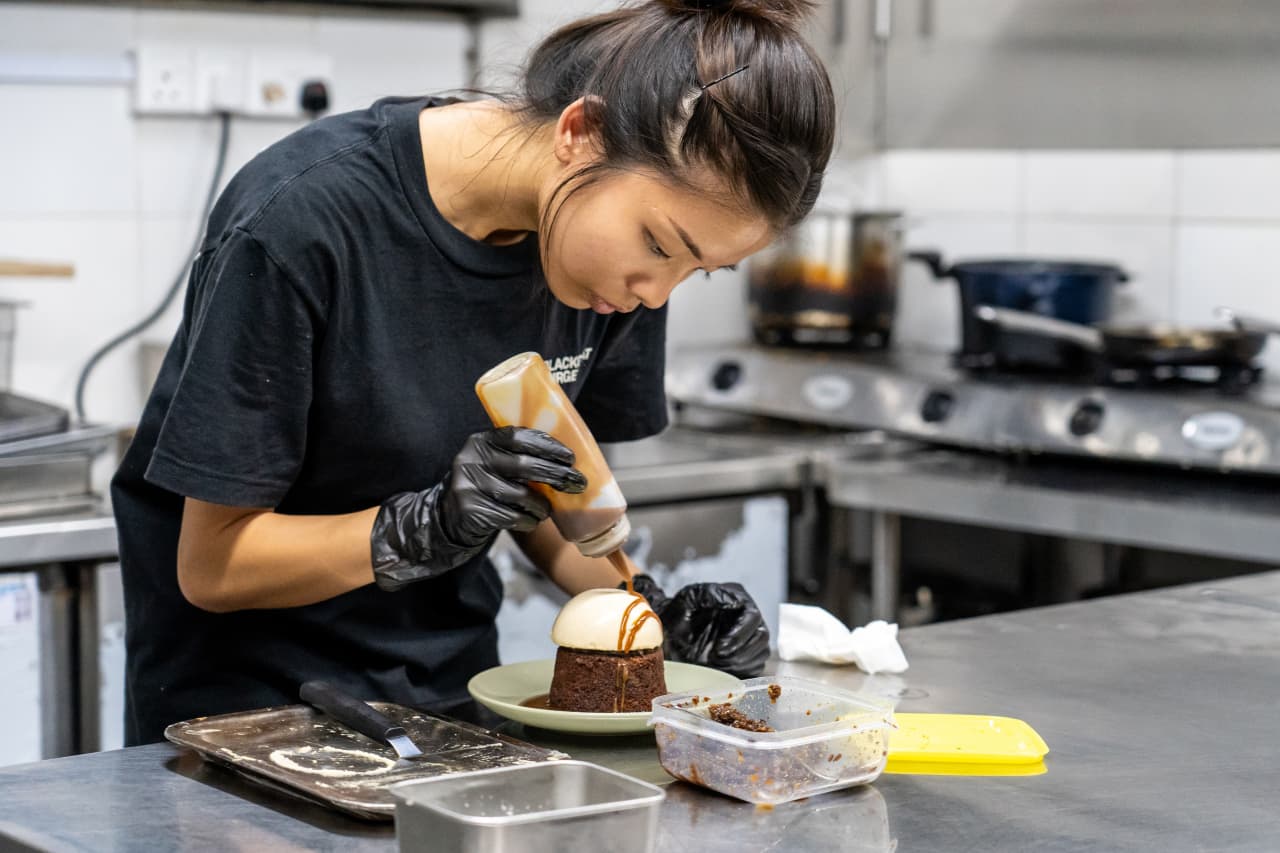The Latest Trend in Your Work Wardrobe Stinks
Performance fabrics move from workout gear to business attire—with some odorous downsides
Performance fabrics are moving out of the gym and into everyday clothes. Some men say that stinks.
The fabrics, usually a blend of polyester, spandex and other man-made fibres, have been a mainstay in workout gear for their sweat-wicking properties. Now apparel makers are using them for polo shirts, button-ups and suits. But a work day or wedding lasts a lot longer than a workout, giving the materials time to trap odours, cause breakouts and make you sweatier.
Tim Connon, a life insurance agent in Palmer, Tenn., got tired of adding a cup of baking soda to the wash to remove the mildew smell from his polyester-blend polo shirts, and eventually tossed them out. “It was ridiculous to have to take that extra step when the shirts shouldn’t smell in the first place,” he said.
Connon now wears only 100% cotton shirts, but said they are hard to find and more expensive. They also have to be ironed. “The performance shirts don’t wrinkle, but I couldn’t stand the smell and the itchiness of those fabrics,” the 31-year-old said.
Synthetic fibers repel water, which helps sweat evaporate but allows oil secretions from our bodies to build up on the fabric and trap odours, according to Renae Fossum, a senior director and research fellow at Procter & Gamble.
P&G has upgraded its detergents and introduced new products like Downy Rinse & Refresh, a fabric enhancer that works in the rinse cycle to strip away odours and residue that builds up on synthetic clothes. “We are trying to help consumers understand these issues are not in their head,” said Sammy Wang, a P&G senior scientist who specialises in fabric care.
Polyester is no stranger to friction. The fibre got its start in the 1930s lab of DuPont chemist Wallace Carothers. After Carothers got sidetracked by the discovery of nylon, British scientists picked up the thread and developed the first polyester fibre during World War II. DuPont bought the U.S. rights in 1946.
In the following decades, the fabric elbowed aside natural fibres like cotton, silk, linen and wool, thanks to its lower costs and easy care—you could throw it in the washing machine and let it drip-dry.
It was also suffocating, at least in its earlier forms. Wearing a 1970s polyester leisure suit was like “walking around in a Hefty bag,” said Alan Spielvogel, director of technical services at the National Cleaners Association, a dry cleaners trade group.
Clothing makers eventually added breathability, stretch, waterproofing and stain resistance. As athleisure took hold, polyester took off. Polyester surpassed cotton in 2002 and now outsells all other fibres, according to consulting firm Wood Mackenzie.
Covid further fuelled polyester’s growth as people got used to wearing more comfortable clothes while stuck at home.
Although women have adopted performance fabrics for dressier attire, men have been the primary driver of demand because they tend to put a higher value on features like stain and wrinkle resistance, said Kristen Classi-Zummo, an apparel analyst at market research firm Circana.
Dermatologists say that with the popularity of these fabrics, they are seeing a jump in “sweat acne,” which is caused by a yeast that lives on our skin that invades our pores when we perspire.
Erum Ilyas, a dermatologist in King of Prussia, Pa., said sweat acne is more prevalent with performance fabrics in casual or work attire than workout clothes. “When you work out, you usually rinse off afterward,” she said. “If you are wearing a shirt for 8 to 12 hours, you are stuck in that fabric for longer stretches of time.”
She tells patients to try using Head & Shoulders shampoo as a body wash to degrease the skin.
Tyler Cenname, the co-founder of a furniture company, purposely chose a dress shirt made of performance fabric to wear to a Las Vegas wedding in August because he thought it would keep him cooler.
“I actually sweated more than if I was wearing a cotton shirt,” the 24-year-old said. “And I broke out in a rash.”
Zach Klempf, the founder of an automotive software company, bought a moisture-wicking suit to keep him dry when presenting to clients and working trade show booths. He hadn’t counted on the suit absorbing cigar smoke during industry cocktail hours.
“I can’t wear it anymore, because the smell is so off-putting,” said the 32-year-old San Francisco resident. He’s gone back to wool suits.
Some performance-fabric fans say the odours are a small price to pay for the added comfort and absence of armpit stains. To combat the stink factor, some brands treat the fabrics with antimicrobial finishes.
That coating can wear off, according to Tony Anzovino, chief sourcing and merchandising officer at Haggar Clothing, which uses performance fabrics in 70% of its products. Instead, Haggar uses a type of polyester fibre that is spun into a longer yarn called a filament that makes it harder for microbes to attach.
Jonathan Poston, a 48-year-old consultant, who lives in Chapel Hill, N.C., wonders if we’re asking too much of our clothes. “In the tech world we call it feature creep,” he said. “The same thing is happening with clothes. They have to tick all these boxes.” He only wears 100% cotton shirts.
“As someone who has to wear a shirt for 14 hours a day, I don’t think it’s unreasonable to ask my clothes to do a lot,” said Ben Perkins, the co-founder of &Collar, a men’s clothing brand that uses performance fabrics. Nevertheless, Perkins plans to introduce a cotton-blend shirt after customers said they wanted one.
“You need to serve the synthetic majority and the cotton minority,” he said.
 Copyright 2020, Dow Jones & Company, Inc. All Rights Reserved Worldwide. LEARN MORE
Copyright 2020, Dow Jones & Company, Inc. All Rights Reserved Worldwide. LEARN MORE
This stylish family home combines a classic palette and finishes with a flexible floorplan
Just 55 minutes from Sydney, make this your creative getaway located in the majestic Hawkesbury region.
No trip to Singapore is complete without a meal (or 12) at its hawker centres, where stalls sell multicultural dishes from generations-old recipes. But rising costs and demographic change are threatening the beloved tradition.
In Singapore, it’s not unusual for total strangers to ask, “Have you eaten yet?” A greeting akin to “Good morning,” it invariably leads to follow-up questions. What did you eat? Where did you eat it? Was it good? Greeters reserve the right to judge your responses and offer advice, solicited or otherwise, on where you should eat next.
Locals will often joke that gastronomic opinions can make (and break) relationships and that eating is a national pastime. And why wouldn’t it be? In a nexus of colliding cultures—a place where Malays, Indians, Chinese and Europeans have brushed shoulders and shared meals for centuries—the mix of flavours coming out of kitchens in this country is enough to make you believe in world peace.
While Michelin stars spangle Singapore’s restaurant scene , to truly understand the city’s relationship with food, you have to venture to the hawker centres. A core aspect of daily life, hawker centres sprang up in numbers during the 1970s, built by authorities looking to sanitise and formalise the city’s street-food scene. Today, 121 government-run hawker centres feature food stalls that specialise in dishes from the country’s various ethnic groups. In one of the world’s most expensive cities, hawker dishes are shockingly cheap: A full meal can cost as little as $3.
Over the course of many visits to Singapore, I’ve fallen in love with these places—and with the scavenger hunts to find meals I’ll never forget: delicate bowls of laksa noodle soup, where brisk lashes of heat interrupt addictive swirls of umami; impossibly flaky roti prata dipped in curry; the beautiful simplicity of an immaculately roasted duck leg. In a futuristic and at times sterile city, hawker centres throw back to the past and offer a rare glimpse of something human in scale. To an outsider like me, sitting at a table amid the din of the lunch-hour rush can feel like glimpsing the city’s soul through all the concrete and glitz.
So I’ve been alarmed in recent years to hear about the supposed demise of hawker centres. Would-be hawkers have to bid for stalls from the government, and rents are climbing . An upwardly mobile generation doesn’t want to take over from their parents. On a recent trip to Singapore, I enlisted my brother, who lives there, and as we ate our way across the city, we searched for signs of life—and hopefully a peek into what the future holds.
At Amoy Street Food Centre, near the central business district, 32-year-old Kai Jin Thng has done the math. To turn a profit at his stall, Jin’s Noodle , he says, he has to churn out at least 150 $4 bowls of kolo mee , a Malaysian dish featuring savoury pork over a bed of springy noodles, in 120 minutes of lunch service. With his sister as sous-chef, he slings the bowls with frenetic focus.
Thng dropped out of school as a teenager to work in his father’s stall selling wonton mee , a staple noodle dish, and is quick to say no when I ask if he wants his daughter to take over the stall one day.
“The tradition is fading and I believe that in the next 10 or 15 years, it’s only going to get worse,” Thng said. “The new generation prefers to put on their tie and their white collar—nobody really wants to get their hands dirty.”
In 2020, the National Environment Agency , which oversees hawker centres, put the median age of hawkers at 60. When I did encounter younger people like Thng in the trade, I found they persevered out of stubbornness, a desire to innovate on a deep-seated tradition—or some combination of both.
Later that afternoon, looking for a momentary reprieve from Singapore’s crushing humidity, we ducked into Market Street Hawker Centre and bought juice made from fresh calamansi, a small citrus fruit.
Jamilah Beevi, 29, was working the shop with her father, who, at 64, has been a hawker since he was 12. “I originally stepped in out of filial duty,” she said. “But I find it to be really fulfilling work…I see it as a generational shop, so I don’t want to let that die.” When I asked her father when he’d retire, he confidently said he’d hang up his apron next year. “He’s been saying that for many years,” Beevi said, laughing.
More than one Singaporean told me that to truly appreciate what’s at stake in the hawker tradition’s threatened collapse, I’d need to leave the neighbourhoods where most tourists spend their time, and venture to the Heartland, the residential communities outside the central business district. There, hawker centres, often combined with markets, are strategically located near dense housing developments, where they cater to the 77% of Singaporeans who live in government-subsidised apartments.
We ate laksa from a stall at Ghim Moh Market and Food Centre, where families enjoyed their Sunday. At Redhill Food Centre, a similar chorus of chattering voices and clattering cutlery filled the space, as diners lined up for prawn noodles and chicken rice. Near our table, a couple hungrily unwrapped a package of durian, a coveted fruit banned from public transportation and some hotels for its strong aroma. It all seemed like business as usual.
Then we went to Blackgoat . Tucked in a corner of the Jalan Batu housing development, Blackgoat doesn’t look like an average hawker operation. An unusually large staff of six swirled around a stall where Fikri Amin Bin Rohaimi, 24, presided over a fiery grill and a seriously ambitious menu. A veteran of the three-Michelin-star Zén , Rohaimi started selling burgers from his apartment kitchen in 2019, before opening a hawker stall last year. We ordered everything on the menu and enjoyed a feast that would astound had it come out of a fully equipped restaurant kitchen; that it was all made in a 130-square-foot space seemed miraculous.
Mussels swam in a mushroom broth, spiked with Thai basil and chives. Huge, tender tiger prawns were grilled to perfection and smothered in toasted garlic and olive oil. Lamb was coated in a whisper of Sichuan peppercorns; Wagyu beef, in a homemade makrut-lime sauce. Then Ethel Yam, Blackgoat’s pastry chef prepared a date pudding with a mushroom semifreddo and a panna cotta drizzled in chamomile syrup. A group of elderly residents from the nearby towers watched, while sipping tiny glasses of Tiger beer.
Since opening his stall, Rohaimi told me, he’s seen his food referred to as “restaurant-level hawker food,” a categorisation he rejects, feeling it discounts what’s possible at a hawker centre. “If you eat hawker food, you know that it can often be much better than anything at a restaurant.”
He wants to open a restaurant eventually—or, leveraging his in-progress biomedical engineering degree, a food lab. But he sees the modern hawker centre not just as a steppingstone, but a place to experiment. “Because you only have to manage so many things, unlike at a restaurant, a hawker stall right now gives us a kind of limitlessness to try new things,” he said.
Using high-grade Australian beef and employing a whole staff, Rohaimi must charge more than typical hawker stalls, though his food, around $12 per 100 grams of steak, still costs far less than high-end restaurant fare. He’s found that people will pay for quality, he says, even if he first has to convince them to try the food.
At Yishun Park Hawker Centre (now temporarily closed for renovations), Nurl Asyraffie, 33, has encountered a similar dynamic since he started Kerabu by Arang , a stall specialising in “modern Malay food.” The day we came, he was selling ayam percik , a grilled chicken leg smothered in a bewitching turmeric-based marinade. As we ate, a hawker from another stall came over to inquire how much we’d paid. When we said around $10 a plate, she looked skeptical: “At least it’s a lot of food.”
Asyraffie, who opened the stall after a spell in private dining and at big-name restaurants in the region, says he’s used to dubious reactions. “I think the way you get people’s trust is you need to deliver,” he said. “Singapore is a melting pot; we’re used to trying new things, and we will pay for food we think is worth it.” He says a lot of the same older “uncles” who gawked at his prices, are now regulars. “New hawkers like me can fill a gap in the market, slightly higher than your chicken rice, but lower than a restaurant.”
But economics is only half the battle for a new generation of hawkers, says Seng Wun Song, a 64-year-old, semiretired economist who delves into the inner workings of Singapore’s food-and-beverage industry as a hobby. He thinks locals and tourists who come to hawker centers to look for “authentic” Singaporean food need to rethink what that amorphous catchall word really means. What people consider “heritage food,” he explains, is a mix of Malay, Chinese, Indian and European dishes that emerged from the country’s founding. “But Singapore is a trading hub where people come and go, and heritage moves and changes. Hawker food isn’t dying; it’s evolving so that it doesn’t die.”
This stylish family home combines a classic palette and finishes with a flexible floorplan
Just 55 minutes from Sydney, make this your creative getaway located in the majestic Hawkesbury region.






















